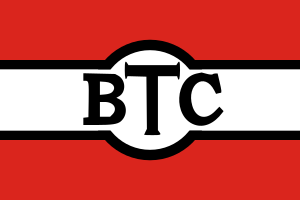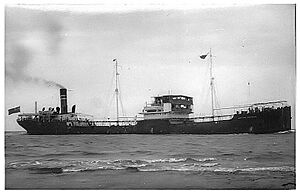British Tanker Company facts for kids

House flag (1915-1927)
|
|
| Industry | Ship transport |
|---|---|
| Successor | BP Tanker Company |
| Founded | 1915 |
| Headquarters | , |
|
Key people
|
Charles Greenway |
| Products | Oil |
| Owner | Anglo-Persian Oil Company Anglo Iranian Oil Company |
The British Tanker Company Limited was a shipping company that transported oil for the Anglo-Persian Oil Company, which later became BP. It was started in 1915 with just seven oil tankers. In 1955, the company changed its name to the BP Tanker Company.
Contents
History
Early Days
When oil was found in Persia (now Iran) in 1908, a big question was how to get it to Britain. At first, the Anglo-Persian Oil Company (APOC) hired other companies, like a part of Royal Dutch Shell, to ship the oil.
In 1912, APOC bought its first ocean-going ship, the SS Ferrara. This ship carried oil in metal cases. Back then, large oil tankers couldn't get close to the port in Abadan because of a sand bar. Ships had to anchor far away, and smaller boats called lighters carried the oil to them. This problem was fixed in the mid-1920s when the sand bar was dug deeper.
1915 to 1945
Soon, the leaders of APOC decided it would be better to have their own ships. So, in April 1915, they created the British Tanker Company Limited (BTC). They ordered seven steam-powered oil tankers from shipbuilders in Tyne. Most of these ships were named with the word "British" at the start. This was because the British government had invested a lot of money in the company to make sure the Royal Navy had enough fuel.
BTC's first tanker was the British Emperor, launched in 1916. She carried oil from Abadan to ports in India. She was the only BTC ship not used by the Navy in World War I. Sadly, she was sunk in 1941 during World War II.
The BTC company grew quickly. By 1919, it had 25 ships, including the Scandinavia, which was the only sailing ship the company ever owned!
Over the next ten years, more and more oil was needed around the world. By 1924, BTC had 60 ships. Their 60th ship, the British Aviator, was special because it was their first oil tanker powered by a diesel engine. It was also the most powerful single-screw motor ship in the world at that time.
BTC ships carried both crude oil (raw oil) and refined oil products like fuel oil and kerosine. In the 1920s, about half of all their oil went to the United Kingdom. Most of this was crude oil for new refineries. India was the next biggest destination.
The Great Depression
When the Great Depression hit in the early 1930s, many shipping companies struggled. But APOC managed to stay strong by joining with other companies. The BTC fleet kept growing until 1931. In 1932, APOC teamed up with Royal Dutch Shell for marketing and distribution in the UK. This meant some ships moved to a new company they owned together, called Shell-Mex and BP. BTC was careful, so only a few of their ships were out of work for a short time. In 1935, as the Depression ended, the company ordered 24 more ships. That same year, the company's name changed to the Anglo-Iranian Oil Company.
Second World War
When Second World War started in 1939, the British government took control of BTC's entire fleet of 93 ships to carry fuel for the armed forces. By 1942, the company was managing 146 ships. Sadly, 44 of their own ships and six managed ships were sunk during the war, especially during the Battle of the Atlantic.
1945 to 1955
Just two years after the war ended in 1945, BTC had rebuilt its fleet to 93 ships, the same number as before the war. They bought 10 American T2 tankers and three former merchant aircraft carriers. They also built 57 new tankers. These new ships helped carry more oil, but they still had to be small enough to fit through the shallow Suez Canal.
In 1951, things changed a lot when Iran took control of its own oil industry. The Anglo-Iranian Oil Company (AIOC) had to leave Iran and find new oil sources, especially in Kuwait and Bahrain. This meant the tanker fleet had to quickly change its routes and jobs to deal with not having oil from Abadan.
In the early 1950s, BTC started building much larger ships called 'supertankers'. These ships were very helpful during the Suez crisis in 1956. When the Suez Canal closed, ships had to sail all the way around South Africa, which added a huge 9,000 nautical miles (16,668 km) to their journey!
In November 1954, AIOC changed its name to the British Petroleum Company. So, on June 1, 1956, the British Tanker Company became the BP Tanker Company. The British Soldier was the first ship to wear the new company's colors.
Subsidiary Companies
Some older ships were not added to the main fleet. Instead, they were run by smaller companies that BTC owned. These ships didn't get the "British" name. Some of these companies included The Petroleum Steam Ship Company and The Lowland Tanker Company. There was also the Shell-Mex and BP company, which was owned jointly with Shell.
House Flag
The first house flag (a special flag flown by a shipping company) of the British Tanker Company had black letters "BTC" in a white circle on a white stripe, all on a red background.
In 1926 or 1927, the flag changed to include colors from Persia. This new flag had a red Cross of Saint George on a white background. In the middle of the cross was a large green diamond shape with a golden lion walking and looking forward. The lion was a symbol of Persia.
This flag stayed the same until 1954, when the golden lion was replaced with a red lion standing on its hind legs.
Images for kids
































